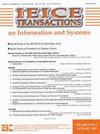Spherical Style Deformation on Single Component Models
IF 0.6
4区 计算机科学
Q4 COMPUTER SCIENCE, INFORMATION SYSTEMS
IEICE Transactions on Information and Systems
Pub Date : 2023-11-01
DOI:10.1587/transinf.2023edp7112
引用次数: 0
Abstract
In this study, we present a spherical style deformation algorithm to be applied on single component models that can deform the models with spherical style, while preserving the local details of the original models. Because 3D models have complex skeleton structures that consist of many components, the deformation around connections between each single component is complicated, especially preventing mesh self-intersections. To the best of our knowledge, there does not exist not only methods to achieve a spherical style in a 3D model consisting of multiple components but also methods suited to a single component. In this study, we focus on spherical style deformation of single component models. Accordingly, we propose a deformation method that transforms the input model with the spherical style, while preserving the local details of the input model. Specifically, we define an energy function that combines the as-rigid-as-possible (ARAP) method and spherical features. The spherical term is defined as ℓ2-regularization on a linear feature; accordingly, the corresponding optimization can be solved efficiently. We also observed that the results of our deformation are dependent on the quality of the input mesh. For instance, when the input mesh consists of many obtuse triangles, the spherical style deformation method fails. To address this problem, we propose an optional deformation method based on convex hull proxy model as the complementary deformation method. Our proxy method constructs a proxy model of the input model and applies our deformation method to the proxy model to deform the input model by projection and interpolation. We have applied our proposed method to simple and complex shapes, compared our experimental results with the 3D geometric stylization method of normal-driven spherical shape analogies, and confirmed that our method successfully deforms models that are smooth, round, and curved. We also discuss the limitations and problems of our algorithm based on the experimental results.单组件模型上的球形变形
在本研究中,我们提出了一种适用于单组件模型的球形变形算法,该算法可以在保留原始模型局部细节的同时,使模型具有球形变形。由于3D模型具有由许多组件组成的复杂骨架结构,因此每个组件之间连接周围的变形非常复杂,特别是防止网格自相交。据我们所知,在由多个组件组成的3D模型中,不仅不存在实现球形风格的方法,而且还存在适合单个组件的方法。在本研究中,我们主要研究单组分模型的球形变形。因此,我们提出了一种将输入模型转换为球面样式的变形方法,同时保留了输入模型的局部细节。具体来说,我们定义了一个结合了尽可能刚性(ARAP)方法和球面特征的能量函数。球面项定义为在线性特征上的l2正则化;因此,可以有效地求解相应的优化问题。我们还观察到,变形的结果取决于输入网格的质量。例如,当输入网格由许多钝角三角形组成时,球形变形方法失效。为了解决这一问题,我们提出了一种基于凸包代理模型的可选变形方法作为补充变形方法。我们的代理方法构建了输入模型的代理模型,并将我们的变形方法应用于代理模型,通过投影和插值对输入模型进行变形。我们将所提出的方法应用于简单和复杂的形状,并将实验结果与法线驱动的球形类比的三维几何样式化方法进行了比较,证实了我们的方法成功地变形了光滑、圆形和弯曲的模型。根据实验结果,讨论了算法的局限性和存在的问题。
本文章由计算机程序翻译,如有差异,请以英文原文为准。
求助全文
约1分钟内获得全文
求助全文
来源期刊

IEICE Transactions on Information and Systems
工程技术-计算机:软件工程
CiteScore
1.80
自引率
0.00%
发文量
238
审稿时长
5.0 months
期刊介绍:
Published by The Institute of Electronics, Information and Communication Engineers
Subject Area:
Mathematics
Physics
Biology, Life Sciences and Basic Medicine
General Medicine, Social Medicine, and Nursing Sciences
Clinical Medicine
Engineering in General
Nanosciences and Materials Sciences
Mechanical Engineering
Electrical and Electronic Engineering
Information Sciences
Economics, Business & Management
Psychology, Education.
 求助内容:
求助内容: 应助结果提醒方式:
应助结果提醒方式:


